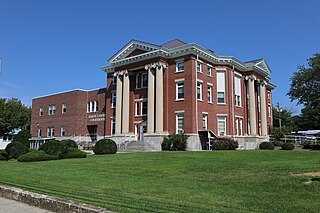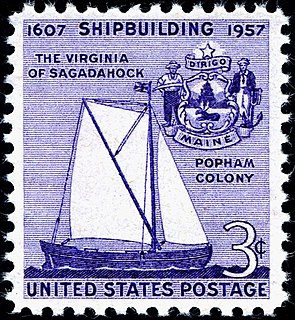
West Virginia is a state in the Appalachian region of the Southern United States, though it is also considered part of the Mid-Atlantic Southeast Region. It is bordered by Pennsylvania to the northeast, Maryland to the east and northeast, Virginia to the southeast, Kentucky to the southwest, and Ohio to the northwest. West Virginia is the 41st-largest state by area and ranks 38th in population, with around 1.791 million residents. The capital and largest city is Charleston.

A schooner is a type of sailing vessel defined by its rig: fore-and-aft rigged on all of 2 or more masts and, in the case of a 2 masted schooner, the foremast generally being shorter than the mainmast. A common variant, the topsail schooner also has a square topsail on the foremast, to which may be added a topgallant and other square sails, but not a fore course, as that would make the vessel a brigantine. Many schooners are gaff-rigged, but other examples include Bermuda rig and the staysail schooner.

Hardy County is a county in the U.S. state of West Virginia. As of the 2010 census, the population was 14,025. Its county seat is Moorefield. The county was created from Hampshire County in 1786 and named for Samuel Hardy, a distinguished Virginian.

The Bermuda sloop is an historical type of fore-and-aft rigged single-masted sailing vessel developed on the islands of Bermuda in the 17th century. Such vessels originally had gaff rigs with quadrilateral sails, but evolved to use the Bermuda rig with triangular sails. Although the Bermuda sloop is often described as a development of the narrower-beamed Jamaica sloop, which dates from the 1670s, the high, raked masts and triangular sails of the Bermuda rig are rooted in a tradition of Bermudian boat design dating from the earliest decades of the 17th century. It is distinguished from other vessels with the triangular Bermuda rig, which may have multiple masts or may not have evolved in hull form from the traditional designs.

In the 18th century and most of the 19th, a sloop-of-war in the Royal Navy was a warship with a single gun deck that carried up to eighteen guns. The rating system covered all vessels with 20 guns and above; thus, the term sloop-of-war encompassed all the unrated combat vessels, including the very small gun-brigs and cutters. In technical terms, even the more specialised bomb vessels and fireships were classed as sloops-of-war, and in practice these were employed in the sloop role when not carrying out their specialized functions.
Jury rigging is both a noun and a verb describing makeshift repairs made with only the tools and materials at hand. Its origin lies in such efforts done on boats and ships, characteristically sail powered to begin with. After a dismasting, a replacement mast and if necessary yard would be fashioned and stayed to allow a craft to resume making way.

William Wallace "Wally" Barron was an American Democratic politician in West Virginia. He was the state's 26th Governor from 1961 to 1965.

The second USS Porpoise was a 224-ton Dolphin-class brigantine. Porpoise was later re-rigged as a brig. She was based on the same plans as Dolphin.

Hurricane Juan was a large and erratic tropical cyclone that looped twice near the Louisiana coast, causing widespread flooding. It was the tenth named storm of the 1985 Atlantic hurricane season, forming in the central Gulf of Mexico in late October. Juan moved northward after its formation, and was subtropical in nature with its large size. On October 27, the storm became a hurricane, reaching maximum sustained winds of 85 mph (140 km/h). Due to the influence of an upper-level low, Juan looped just off southern Louisiana before making landfall near Morgan City on October 29. Weakening to tropical storm status over land, Juan turned back to the southeast over open waters, crossing the Mississippi River Delta. After turning to the northeast, the storm made its final landfall just west of Pensacola, Florida, late on October 31. Juan continued quickly to the north and was absorbed by an approaching cold front, although its moisture contributed to a deadly flood event in the Mid-Atlantic states.

The skipjack is a traditional fishing boat used on the Chesapeake Bay for oyster dredging. It is a sailboat which succeeded the bugeye as the chief oystering boat on the bay, and it remains in service due to laws restricting the use of powerboats in the Maryland state oyster fishery.

USCGC Reliance (WMEC-615) is a United States Coast Guard medium endurance cutter. She is the first of the 210' Medium Endurance Cutter Fleet and the fourth Revenue Cutter / Coast Guard Cutter to bear the name Reliance. Constructed by Todd Shipyards in Houston, Texas and commissioned in 1964, she was originally homeported in Corpus Christi, Texas. Her duties included offshore oil rig inspections, fisheries, counter drug, alien migrant interdiction, marine pollution patrols, and search and rescue. Reliance has been homeported in Yorktown, Virginia, Port Canaveral, Florida and New Castle, New Hampshire. She is currently stationed at the Pensacola Naval Air Station Pensacola Florida

The pungy is a type of schooner developed in and peculiar to the Chesapeake Bay region. The name is believed to derive from the Pungoteague region of Accomack County, Virginia, where the design was developed in the 1840s and 1850s.

Virginia or Virginia of Sagadahoc was a pinnace built in 1607–08 by colonists at the Popham Colony. The ship was a project of the Plymouth Company, branch of the proprietary Virginia Company, on land England claimed as belonging to the Virginia Colony. She was the first English-built ship in what is now Maine and possibly in all of the English-colonized areas of North America, and a demonstration of the new colony's ability to build ships. The second and third "local" pinnaces were built soon afterwards in Bermuda following the loss of Sea Venture during the Third Supply.

As a ship's boat, the pinnace is a light boat, propelled by oars or sails, carried aboard merchant and war vessels in the Age of Sail to serve as a tender. The pinnace was usually rowed but could be rigged with a sail for use in favorable winds. A pinnace would ferry passengers and mail, communicate between vessels, scout to sound anchorages, convey water and provisions, or carry armed sailors for boarding expeditions. The Spanish favored them as lightweight smuggling vessels while the Dutch used them as raiders. In modern parlance, "pinnace" has come to mean an auxiliary vessel that does not fit under the "launch" or "lifeboat" definitions.

Virginia's 35th Senate district is one of 40 districts in the Senate of Virginia. It has been represented by Democratic Senator Dick Saslaw, the current Senate Majority Leader, since 1980.
First-seeded Alice Marble defeated second-seeded Helen Jacobs 6–0, 8–10, 6–4 in the final to win the Women's Singles tennis title at the 1939 U.S. National Championships. The tournament was played on outdoor grass courts and held from September 7, through September 17, 1939 at the West Side Tennis Club in Forest Hills, Queens, New York.

Mattaponi Wildlife Management Area is a 2,542-acre (10.29 km2) Wildlife Management Area (WMA) in Caroline County, Virginia. Located west of Bowling Green, the area protects a mixture of wetlands and upland forests at the confluence of the Mattaponi and South rivers.


















